Article begins
Author’s note: “Aeroroute” is a composite term I introduce in this article to capture the unique material character of what Stuttgart locals call Frischluftzufuhr, Frischluftschneise, Kaltluftschneise, or Luftleitbahnen, all of which refer to a passage through which fresh and cool airs flow. Route—a space created from movement—is one of four types of spatial figure in sociology of space (as proposed by Martina Löw and Hubert Knoblauch). The prefix “aero” comes from the Greek noun “meteoron” and adjective “meteoros”: “meta” means a higher level, while “aoros” means elevated, floating in the air. As explored by the philosopher of winds Rainer Guldin, the meaning of the term “meteor” today has shrunk to refer only to extraterrestrial objects that enter the Earth’s atmosphere, which many people picture as a fireball in the sky. Together with Guldin and philosophers such as Michel Serres and Arden Reed, I also aim to bring the wider sense of the term meteor—as various atmospheric forces and events—back into the discourse of philosophy, humanities, and beyond.
As soon as I, a Jakarta-born ethnographer, experienced my first summer in Munich in 2016, I was surprised by the German habit of “naturally” airing rooms (lüften), in which the locals open and close windows or doors regularly, cutting a path for currents of fresh, cool air (Durchzug) to make its way from one inlet to an outlet. In Jakarta, houses and offices are often designed to prioritize electrical ventilation over the manual kind; people rely on air-conditioning (A/C) devices or electrical fans to cool their offices during the day and their bedrooms at night. In Germany, I found myself in the opposite situation: I had never lived in an apartment nor worked in an office that had A/C. In Munich, my office had an electrical fan—the best I could get to combat the summer heat. I quickly had to learn the art of airing (and closing my curtains during the day).
I was once again surprised in Stuttgart when I did my fieldwork. Stuttgart has the reputation of being a city with significant air pollution and extreme summer heat, but apparently, German people love to air not only their rooms, but also their cities. I had dinner with a friend, Claudia Mendes—a former colleague in Munich—and her family around New Year’s Eve 2023, and she told me, “This city is crisscrossed by wind corridors [Frischluftschneisen], channeling fresh air from green spaces on higher ground to the literal downtown, the lower and the hotter parts of the city.” From the perspective of her father, Hans-Christoph Bernhard, the city’s commitment to aeroroutes was a mixed bag: “For landowners, like me, it means a set of restrictions. It could be unfortunate. I cannot, for example, expand my house even though there is an available space, a garden behind it.”
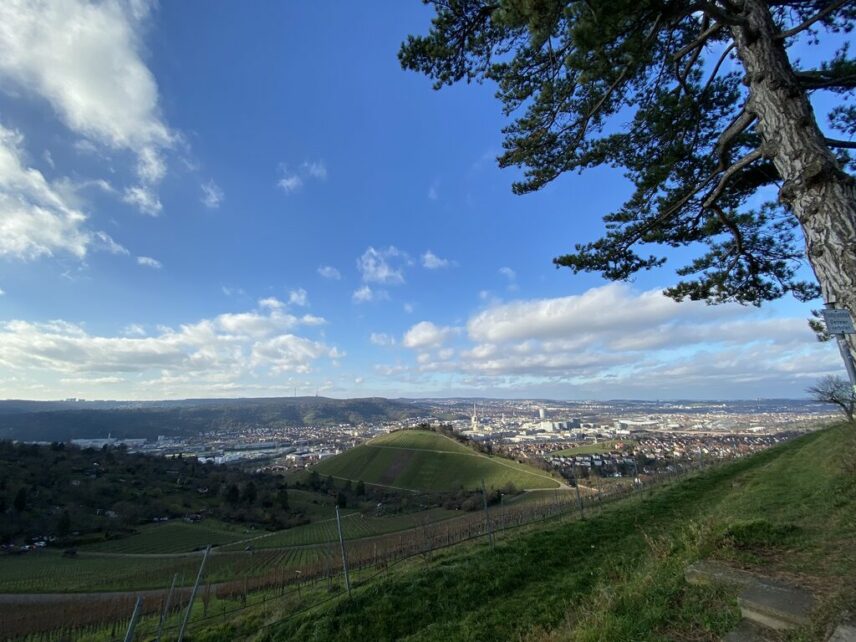
Circulation
Stuttgart is known as a city where empirical urban climatology was born, albeit accidentally. Karl Schwalb, the first meteorologist hired by the City Council in 1938 to work in the Office of Chemical Investigation, experimented with chemical fog seedings as part of the Nazi regime’s compulsory military service. The goal was to conceal valuable buildings in the city center and protect them from the Allies’ air raids. While the primary experiment failed because pilots could still locate their targets using radar, Schwalb identified urban air routes from his observations, so he knew where fresh and cool air flowed or got stuck.
According to postwar documents in the Stadtarchiv Stuttgart, Schwalb was employed by the city in the same office again and tasked with formulating a microclimate planning program (Klimaplanung) for the postwar reconstruction project of severely destroyed Stuttgart. Based on his observations of wind patterns in the city, he proposed that certain areas should be protected using microclimate planning principles, so that the fresh air supply (Frischluftzufuhr) could flow unobstructed from places like the forest areas on the city’s western side. As it expanded from a one-person job, climatology became a section (Abteilung) in Stuttgart in 1961, with a number of scientists and technicians led by Schwalb. In 1976, at the end of his leadership, a short film about the application of urban climatology to urban planning—showing Schwalb in a brown suit describing the arrows of aeroroutes on the city map—was screened at the first UN-Habitat conference in Vancouver.
The 1980s were a period of intense experimentation by meteorologists in Stuttgart and their comrades in the Ruhr metropolitan area. There was a sort of spatial turn in urban climatology, thanks to the new qualitative mapping method and the development of the concept of climatope. Climate was spatialized. Peter Stock and his successor, Wolfgang Beckröge, formulated a new climate-analysis technique in the Ruhr area and tested it in cities such as Mühlheim, Essen, and Dortmund. Previously, urban climate maps had been drawn according to temperature gradation and did not differentiate the thermal specificity of one area’s landscape features from another, but the climate analysis proposed by climatologists in Stuttgart and Ruhr made the distinction. They suggested using a climatope, a term borrowed from the discipline of landscape ecology, as the smallest climatic-spatial unit of representation in which the microclimate characteristics are considered to be similar. A water climatope, for example, is the coolest area in the city during the day and can assist air exchange around its immediate shoreline, different from an inner-city climatope with its strong heat-island effect. This climate-analysis technique using climatope types became an essential reference for the 1992 landmark publication of the Climate Atlas of Stuttgart Metropolitan Area.
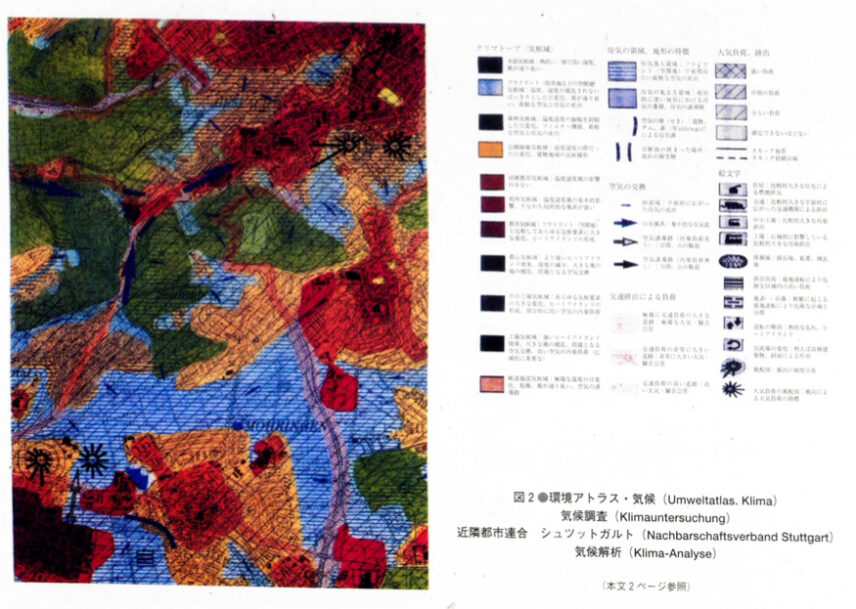
After the publication of the Climate Atlas, Stuttgart boosted its position as a global reference for other regions looking to implement wind corridors as a primary urban climatological planning feature, especially Japan. In 1994, the first Japanese-German Meeting on Urban Climatology was held in Karlsruhe. The then-leader of the Section of Urban Climatology of the city of Stuttgart, Jürgen Baumüller, and his colleague from the Ruhr metropolitan area, Wilhelm Kuttler, traveled to Japan more than a dozen times to transfer knowledge and train environmental engineers, architects, and planners to be urban climatologists. A Japanese version of the Climate Atlas and eight bilateral meetings are the product of their long-lasting collaboration. Nevertheless, the application of German urban climatological concepts in Japanese cities was difficult, if not nearly impossible, because dense high-rise buildings already occupied the urban spaces. Kobe was one city that could replan its urban spaces, but only because the Great Hanshin Earthquake of 1995 had crumbled its buildings and infrastructures.
Some scholars celebrate Stuttgart as a successful model of application of climatology in urban planning and point out the failed circulation of knowledge from German-speaking cities as the main problem. In my view, there is something missing from that calculus, though: the application of climatology in urban planning still requires extensive programmatic effort and is rife with conflicts and barriers, even in Germany.
Planning without Air-Conditioning
If Daniel Berber’s Modern Architecture and Climate: Design before Air Conditioning is a compendium of buildings historically designed before the massive proliferation of A/C, then Stuttgart is a living example of planning before and without A/C. This type of planning requires collaboration between urban climatologists and planners, and climatopes are a crucial element in the collaboration, because with them (according to the urban climatologists I’ve interviewed), climatological language can be translated into something urban planners understand.
Furthermore, planning without A/C requires a continuous socialization and usually involves residents in the collaboration—making climatology public. This is sometimes accomplished through newspaper articles, pamphlets, exhibitions, tours, radio broadcasts, CDs and DVDs, and websites. Some members of citizen action groups learned about urban climatology in those ways; for example, key media in the 1990s–2000s, before modern citywide internet availability, was “STADTKLIMA (URBAN CLIMATE) 21,” a set of discs that contained a wind simulation program. Today’s urban climatology is a public science in Stuttgart. All Stuttgarters I met had at least a basic knowledge of Stuttgart’s specific topography (der Kessel: the kettle, a boiler whose bottom is the hottest), if not also different winds and their routes in their city. However, the fact that urban climatology has become a public science comes with a consequence: the wind corridors are not only a designated top-down regulation/instruction from experts to laypeople, but the latter also can protest—and have protested—against construction projects along those routes and demanded protection of the routes.
These sociospatial conflicts along the aeroroutes could be read as a political statement against the long dominance of conservative parties and groups at the local level led by the Christian Democratic Union (CDU). In the 2000s, a social movement emerged in which concerned citizen groups (Bürgerinitiativen) protested against a plan to convert green areas at the city’s periphery into buildings, which culminated in 2009, when the Green Party won the communal election for the first time. The local council’s conservative majority aspired to dedicate these areas for high-priced, surface-sealing, single-family homes for higher earners. Hypocritically and cunningly, the primary justification for their aspiration was the urgent need to alleviate the housing shortage for low- and middle-income households.
The citizen action groups highlighted different issues, from conserving endangered species to preserving cultural landscapes. Still, they share one leitmotif: they all spoke in the name of protecting the aeroroutes. Jürgen Lessat and Gretel Quiring, the founders of Frischluft für Cannstatt (which means Free Air for Bad Cannstatt, a district of Stuttgart), shared their experiences of organizing explicit protests against a building project planned on the land of a farmer whose family member was a member of the CDU. They published a series of Kaltluftpost (a pun meaning “cold air post”) newsletters, wrote letters to the editors of local media, built a wood tower on the intended building site, hung posters in the district, organized a collective painting event for children on the route, and led a public-information campaign against the construction projects. They deliberately and provocatively named the CDU and its coalition as “climate killers” in one of their publications, for example. The election result, in which the CDU suffered heavy losses, testified to the success of their political engagement.
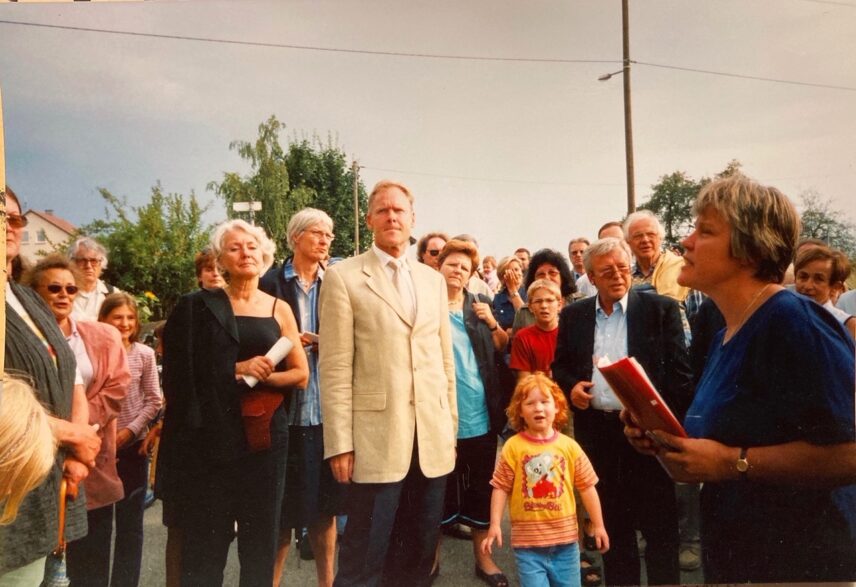
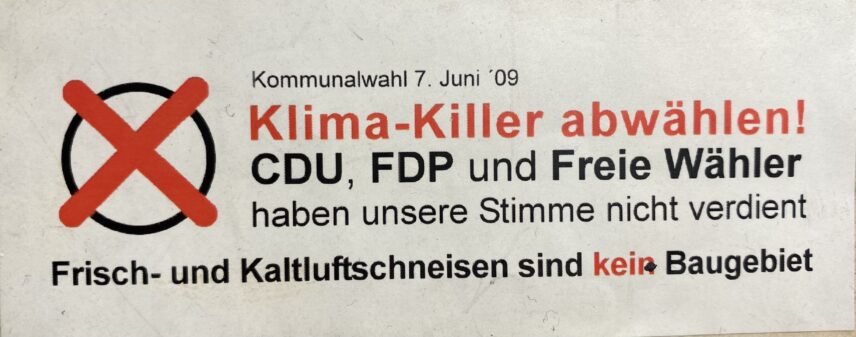
The conflicts sometimes also extended into legal battles. The Schutzgemeinschaft (Conservation Society) of Rohrer Weg, an organization of neighbors in the same district (Möhringen) and citizens from other districts who sought to maintain a type of traditional landscape (Streuobstwiese, equivalent to “meadow orchards”) on lands that were not owned by the organization’s members, had to swallow the bitter pill. Despite years of campaigning and land-use reclassification as a protected area, the land was reclaimed from the city of Stuttgart by private landowners in administrative court. The lawyers of landowners used juridical archaeology to win the case: they unearthed a special instruction under the authority of the führer that had been issued on the eve of World War II, made it valid again, and thereby canceled the building plans after 1942. In another lawsuit, a corporation requested an evaluation of an informal planning instrument enacted by the municipality—the so-called Semi-Valley Framework Plan (Halbhöhenlagen Rahmenplan)—that forbade construction projects on an almost circular slope through which fresh and cool airs flowed, because the plan affected their intention to expand a building on a privately owned land. The administrative court decided the company’s request for legal review was admissible but unfounded. The case now serves as a precedent for restricting construction projects in microclimatically relevant spaces on the valley’s slope.
The Future of Aeroroutes
At the Theatre of the Long Now, “an installation and a performance piece” in a public wasteland (Brachen, which in German also has an agricultural connotation) meant to be performed over “at least 100 years.” The theater is an art project that is performed so that the wasteland will not be built and can make more free space for fresh air. It is a ground to test out how art formats can be used to secure public spaces against the pressure from investors. I attended the one-hour show and found myself wondering whether aeroroutes can survive or even expand as a way to cool residents without energy expense (and consequence). I am pessimistic about that, even in Stuttgart. It seems like a David-versus-Goliath fight, where Goliath is an assemblage of landowners, lawyers, financiers, politicians, and companies (both public and private) fighting over the land in the city where the cost of living is among the highest in Germany. Of note, the fight involves a dissonance between what is written in official documents and what is actually implemented. For example, in the case of Rohrer Weg, despite it being written in an official draft that construction at the meadow is “an uncompensated incursion into the lands where fresh air is produced and into the relevant fresh air system at the southern part of the city” and the fact that local council members from the conservative coalition have publicly explained the importance of the meadow to the citizens, in the end, new buildings were still built there.
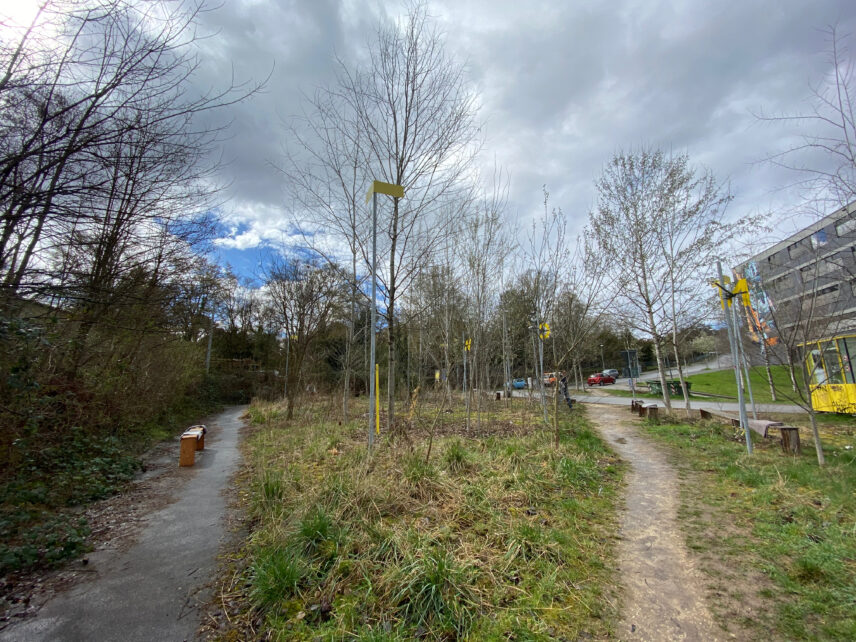
Political complications also aren’t confined to land disputes. The idea of allying with nature in a “more-than-human” collaboration isn’t always pure. In Tamm and Asperg (two smaller cities that constitute Stuttgart Metropolitan Area), the winds have been politically instrumentalized to meet another agenda: citizens and politicians have argued that housing for immigrants will block the aeroroutes.
Although the population of Stuttgart never dramatically multiplied in the post–World War II era, the city has only expanded—and of course, more buildings have been built, although they tend to be shorter than many American or Asian buildings. But there has never been any official and continuous evaluation of the wind corridors in Stuttgart. Less an entity, more of an intensity, “a force with variation,” the winds are difficult to measure and require specific attention—meticulous design—to maintain. I asked an urban climatologist who was also an expert witness in one of the legal trials whether the disappearance of the routes is just my sentiment or might have an actual bearing. Her answer: “That is the correct estimation, that climate-relevant areas are already gradually defeated by a conversion into buildings and a redensification of existing buildings.”
There is a German term for that, of course: Siedlungsdruck (settlement pressure, which seemed to appear mostly in the 1990s in the context of Germany’s post-reunification era), the predisposition of human-occupied territory to congeal and close a gap. Non-electrical cooling by means of preserving the aeroroutes raises an existential question about the possibility of caring for urban population growth without building new structures, thereby allowing “empty” green spaces to remain and function as the city’s ventilation. Such an existential question begets even more fundamental questions for humanity. Taking into account that construction projects have been one of the motors of urban development and economic growth, what would be the effect of not building? Can we maintain the economy and support climate adaptation and mitigation? Would it still be called “development” and “growth”? These questions imply that the maintenance of aeroroutes as a non-electrical cooling infrastructure is still costly: it costs the city spatial conflicts and necessitates a different urban world that doesn’t exist today.
Acknowledgments
This research project is part of the Collaborative Research Center 1265, Re-figuration of Spaces, funded by the German Research Foundation. I thank Jürgen Lessat, Norbert Michel, and Hannes Schwertfeger for their detailed comments, which are incorporated into the final version of this article. Special thanks to Christopher Heidecke, who has edited the video for this article. I finally thank Ignacio Farias, who has crafted the groundwork of the research project.

